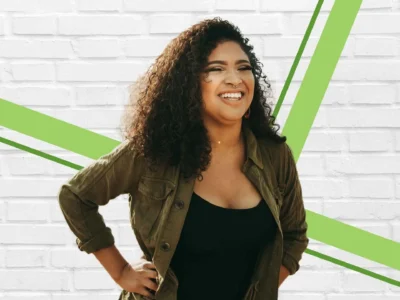Mission Investment Director Cynthia Muller talks race, systemic barriers and equitable opportunities in capital markets with hosts Nick Ashburn and Sandi Hunt on Dollars and Change, the University of Pennsylvania’s Wharton Business School’s SiriusXM podcast.
The W.K. Kellogg Foundation maintains a focused Mission Driven Investment program that seeks to reorient the investor practices and behaviors that interrupt and influence capital markets. By deploying both grant and investment capital – using a systematic racial equity approach – we can help dismantle systemic hurdles and create opportunities for all communities to thrive.
Check out the following excerpts from the podcast below and visit wkkf.org to learn more about the WKKF’s Mission Driven Investment Portfolio. These excerpts have been edited for clarity.
(Sandi Hunt 18:54) A reminder to our listeners, we’re talking to Cynthia Muller, director of mission investment at the W.K. Kellogg Foundation. Let’s continue on that thread, Cynthia, talking about the priorities of giving of the foundation and how that’s incorporated into the impact investing targets and what’s possible. Can you talk to us a little bit about how you define the impact objectives of both the foundation and then does that one-to-one also become the impact objectives of your impact investing?
(Cynthia Muller 19:37) As you mentioned, about 20 or more years ago we were doing a lot of research around racial equity. We were very much structured, at the time, like an academic foundation; doing a lot of research, helping to inform our partners in the business sector and private sector of what we’re learning. That helped to guide our commitment to becoming an anti-racist organization in 2007. This actually plays out in a couple of ways; on the programmatic side, our core is children. We do this through creating equitable communities, access to reliable health care, access to healthy food and high-quality education. Across all of that is, we look at it through a lens of racial equity.
We want to understand who is benefiting and who isn’t, on the programmatic side and on the investment side. That’s the core question that we’re asking. Who’s benefiting and who isn’t? From there we start to back out, who isn’t benefiting? Let’s understand who those folks are relative to who our target is. Is this good enough? Is the projected impact going to be something that will align to the goals that we, that our board mandates for us here at the foundation?
For instance, the way that this plays out on the deal is, we’ll start to look at potential borrowers or investees of a fund manager. And we start to understand how are they connecting to underrepresented entrepreneurs or enterprises. How does this [racial equity] lens actually play out in their strategy? This is not to say that every one of our managers is investing in Brown and Black communities. They are not explicitly, in some cases. However, they are starting to think differently about their networks and thinking differently about opportunity. Which, in turn, is creating stronger investments and connections to folks that many of our managers won’t even come in contact [with].
(Sandi Hunt 21:45) Cynthia, can you give us a few examples there? Just to color this for our listeners. When you’re talking about how managers are looking at prioritizing a racial equity lens in the entrepreneurs they’re seeking. What are some things that you see that you say, “Yes, those are the indicators we want to see. That’s the behavior that we like to see.”
(Cynthia Muller 22:09) A recent investment we did was with a group called Better Ventures out of Oakland, California. It’s these two guys, actually, it’s their second fund. What we’re really intrigued by is that they are Oakland based, so not out of San Francisco, trying to hit a different ecosystem. And they are two white guys. They’ve got an associate, a female associate, and very, very committed to impact. They obviously know us as the Kellogg Foundation and I said to them, “Listen, I’m not coming in as a potential LP to change your strategy. I would never tell you to go as an LP to different communities. What I am going to ask you is how are you thinking about the communities and the entrepreneurs you are working with? And who is missing?” That’s basically what it boils down to. Then we start a conversation.
(Sandi Hunt: 23:00) What’s a good answer to that conversation, or some sort of nuance that tells you they’re thinking about this in the right way?
(Cynthia Muller: 23:08) It’s really about networks. It’s really about those folks who say, “You know what, we are not in the Hispanic community. We are not with the Black community. We don’t know anything about this community,” and are they ready to answer that blind spot. The same way they would if they were talking about sectors. If your team had the right sectorial focus or you had the right people in the team. That’s how we’re thinking about it because we don’t want to make this a zero sum. You have to give X in order to do investments in Black and Brown communities. That’s not what we’re saying at all. What we’re saying is that there are upsides for many players in this field. It’s really about how we understand what opportunity looks like.
What we’re saying is that there are upsides for many players in this field. It’s really about how we understand what opportunity looks like.
(Nick Ashburn: 23:47) Well, I think you bring up a really, really interesting point and my personal opinion is that you don’t necessarily have to have the business case to invest with this thesis, but rather there is. It’s a real win-win here. When you think about what’s missing, and I reflect on our investment strategies through Wharton Impact Venture Associates, that hustle, those networks, that’s a key differentiator for you in your investment strategy, or you’re sourcing the same deals that everyone else is. Talk about the dollars being left on the table, or the real opportunity set, when you think about what’s missing.
(Cynthia Muller: 24:19) I think about the student loan financing space, we have been monitoring that crisis, pretty closely. It’s going to already have an adverse effect on many of our communities because as many of us have been told, education is such a paramount of importance, but also at the same time it’s not accessible for all. And with student loan financing, in particular, you’re seeing a lot of actors coming out. Obviously, we’ve got actors like SoFi and then we’ve got smaller actors like Sixup who are really trying to change the way that first gen[eration students], which predominantly ended up being kids of color, are actually engaging with higher-ed[ucation] in a meaningful way, so they are actually successful. Versus flunking out or having to withdraw because they can’t get their resources together.
So, it’s a double down on high performing low-income students. I think for Sixup, you would look at their company, and when you talk to them and you know that these folks have lived the experience of being students who have had to put themselves through colleges through multiple jobs and what have you. I think for me, this is the factor. Better Ventures immediately was like, “You know what? Actually, here’s where we have gaps.” Sixup is immediately like, “Listen, we know that these are the students that are being left out.” It’s connecting the opportunity gap with the strategy. I think that’s what’s different for folks versus we need to just get Brown borrowers or Brown people to come work for us.
That’s one strategy and it’s helpful, but it’s not the only strategy. What we’re trying to push is more of this [racial equity] lens, and helping folks to understand what’s being left out, what’s there and who is engaged and who isn’t. Because I think oftentimes in impact, or even philanthropy, people get really enamored with the vision, the pictures of the beautiful smiling, healthy babies and all of that. But at the end of the day, how many starving babies are we not getting to? That’s where we’re really trying to take it, and really hold the light to those folks, who, quite frankly, in this environment nobody else is paying attention to them. So, it’s important for us and our peers who are focused on this to really raise that up to our investees and partners.
And I think the other piece of it too, is really understanding community. I think this whole conversation is around power. I know you’re going to be talking about reparations later in the show, but this notion of who has power, how do we see power in a thoughtful way, and how do we encourage the development of power in communities? So, our hope is that our managers, each one of our managers who have several dozen companies underneath each one of them, are realizing that and helping our entrepreneurs to negotiate that power dynamic in their communities. Especially as they’re engaging underrepresented or marginalized communities.
(Nick Ashburn: 28:04) Is there anything else? Just as we wrap up this segment. What would you say are things that our listeners could continue to take away? Maybe they are an entrepreneur, as Sandy said, or they want to be supportive of the type of work that you’re doing. What would our listeners be able to do?
(Cynthia Muller: 28:20) I think at an individual level, it’s really about just looking and really seeing how systems are impacting our communities in a negative way. For instance, I was just at a bus depot in some random city and just was watching people coming in and out and thinking about the time of the month and why the flow of these particular type of folks are coming in. Especially with the end of this school year. I think it’s being able to look at these systems and then think about, well what’s the play here?
How do we actually start to create different incentives for market players? How do we give more power to the consumer? How do we actually create better collaborations amongst different types of investors? I think that’s what really gets me excited about this work. I think that’s where the opportunity is in this space. Also, because we have such a dearth of actors coming out, I’m just excited about all these different players, we need to be sharing these stories and these insights because this work is too hard. And, quite frankly, there’s no [static] roadmap either.





Comments